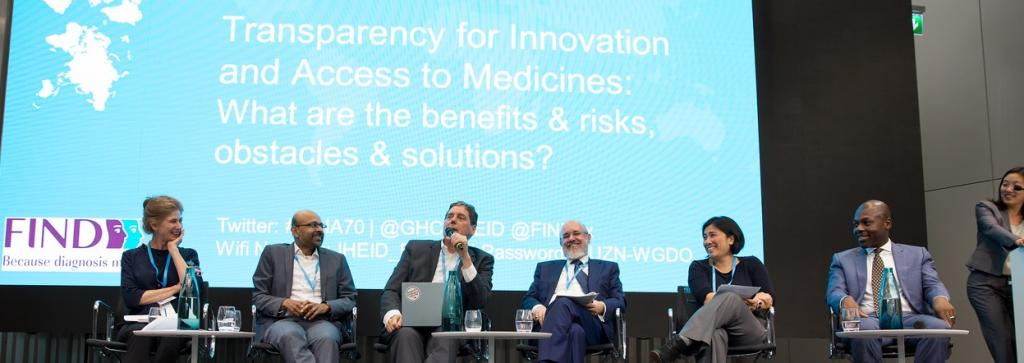“Innovation and access to medicines is no longer an issue for developing countries, it is a true global policy concern”, asserted Professor Ilona Kickbusch when opening the panel discussion “Transparency for Innovation and Access to Medicines: What are the benefits & risks, obstacles & solutions?”, convened by the Global Health Centre, in collaboration with FIND, on 23 May 2017, on the occasion of the 70th World Health Assembly. Following the United Nations Secretary General’s High Level Panel on Access to Medicines’ call for increased transparency in various aspects of the pharmaceutical market, the event brought together governments, industry, civil society and others to tackle different fields in which transparency is currently considered, and discuss its underlying benefits, challenges and risks.
Information on medicine prices emerged as a key element to address asymmetric negotiating power between sellers and buyers. Dr. Clemens-Martin Auer, Director General of the Austrian Federal Ministry of Health, expressed concern over the fact that a fragmented and opaque market has led “not only to market failures, but also policy failures”, and that affluent countries willing to accept higher medicine prices are used by pharmaceutical companies to ratchet prices upwards in other countries. To enhance their bargaining position, states have formed alliances such as the Benelux Collaboration to Lower Orphan Drugs Prices, which Austria recently joined, to share information and coordinate negotiating strategies.
Health R&D is another field in which calls for transparency have increased. Wider access to data on R&D costs disaggregated by medicine could not only contribute to fairer pricing of medicines but also to a more reliable evaluation of R&D efficiency. Mr. James Love from Knowledge Ecology International invited the public to consider “how much the monopoly increases price and what the population gets back in terms of how much is invested in R&D”. On the other hand, from the perspective of the private sector, Dr. Fumie Griego, Assistant Director General of IFPMA, emphasised the need to bear in mind the complexity of the R&D system and to balance desired disclosure with private interests, in order to encourage investment in products that meet future needs.
Regarding the investigative stage of medicine development, Dr. Vasee Moorthy from WHO highlighted that “clinical trials are central to health decision making; it is difficult to understand that we have such little information on them”. Despite the WHO International Clinical Trials Registry Platform being in place, the results of many clinical trials are not published. Dr. Moorthy expressed optimism that this trend is changing, based on the agreement of key stakeholders on how to increase transparency of trial results.
Presenting a perspective from non-profit product developers, Ms. Sharon Saacks of the Foundation for Innovative Diagnostics (FIND) pointed out ways in which product development partnerships (PDPs) can increase transparency in key aspects of the pharmaceutical and diagnostics market. For example, on clinical trial results, product prices, and research data, PDPs systematically make information public and are less constrained by fears of loss of competitive advantage than the private sector.
Finally, Dr. Tenu Avafia from UNDP, which also served as the Secretariat of the UNSG’s High-Level Panel, highlighted the challenge of obtaining information regarding the patent status of medicines in many countries. While the Medicines Patent Pool has significantly increased patent transparency by publishing databases on the patent status of medicines for HIV, hepatitis C and tuberculosis, there is room for enhanced transparency for other diseases. Dr. Avafia proposed the involvement of WHO and WIPO as a unique contribution to the availability of better information on the international common names of biologics, international non-proprietary names for pharmaceuticals and dates of patent application, grant and expiration.
The event has revealed that there is a growing interest in this area. Although this is not sufficient to fully address innovation and access challenges, a broad range of stakeholders and sectors need to be engaged, as this is an issue that is here to stay.


